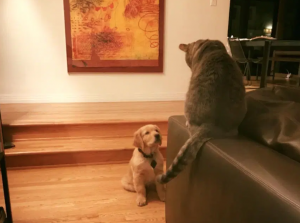Dogs, Cats & Couples

Introducing a Golden Retriever puppy into the household has been a delight…to everyone but our 10 year old rescue tabby cat. She doesn’t appreciate his quick movements, sloppy water drinking or sharp barks that say “Notice me!” She interprets his play bows as aggression and returns with hissing, spitting and swipes at his little nose. However, in the six months they have co-existed, she has never actually harmed him. Rather, she sends out warnings and presents a considerably louder “bark than bite.” They remind me of various couples I’ve seen in my practice over the years. The puppy is what we call The Pursuer while the cat is The Distancer.
The Humans
These couples have a carefully choreographed dance that requires each to consistently play their role. Pursuer tends to “lean in” by asking more questions, initiating physical contact, conversation and sex. Distancer acts more as a gatekeeper by setting the pace, intermittently denying the attempts at contact and isolating themselves from the other. Researcher Dr. John Gottman points to this pattern as a common cause of divorce.
When these couples come to therapy, it’s often the Pursuer leading the charge. They want more access to their partner–emotionally and sexually. They want intimacy and more shared experience. The Pursuer is willing–even insistent on making eye contact in session. They tend to talk more and come with ideas for exercises as well as notes from how the couple interacted during the week. The Distancer hasn’t “done the homework” or so it seems. Sometimes they have actually tested their theory in quiet, more covert ways. They will acknowledge when I ask, but hold out when their partner makes similar inquiries.
 I’ve found clues in the pets that seem telling with the humans. Our Golden Retriever puppy is unconditionally loving and simple in his desire for attention, touch and play. The cat hangs back. She likes to approach on her terms–typically when things are quiet, calm and we are settled. While the dog can be trained to obey with consistent commands and high value treats, the cat won’t come when we call, nor be swayed by the best food. She wants it, but not at the cost of compliance.
I’ve found clues in the pets that seem telling with the humans. Our Golden Retriever puppy is unconditionally loving and simple in his desire for attention, touch and play. The cat hangs back. She likes to approach on her terms–typically when things are quiet, calm and we are settled. While the dog can be trained to obey with consistent commands and high value treats, the cat won’t come when we call, nor be swayed by the best food. She wants it, but not at the cost of compliance.
Trauma
Above I noted that she is a rescue, which adds complexity to her temperament. I see this much like the overlay of trauma, which impacts many clients. She is guarded, slow to trust and sometimes not all that grateful for the gifts we offer. Similarly, the client who comes with trauma in their past tends to be less able to trust their feelings, respond in real time to emotional calls and show empathy for others. They are too busy trying to keep safe from perceived (emotional) threats.
The American Kennel Club says to let the animals work it out–negotiate their boundaries. It’s also important to help the dog with impulse control. Dogs so desperately want to chase the cat when it runs from them. But that is the worst thing they can do. Rather, if they can hold steady and ignore the cat, it will result in a more harmonious coexistence. The challenge is that instinctively, when she runs (from fear), he is excited and chases, which only makes her more afraid.
Much the same, when our Pursuer client “chases” by repeatedly try to make contact (verbal and non-verbal), the Distancer will run (shut down or withdraw). This may also look more like aloofness or declined invitations for sex or togetherness. However, if the Pursuer can hold steady, the Distancer often takes a step toward them. Sometimes, they even switch roles. Ideally, they stay in a middle area of balanced communication and initiation.
Together for a Reason
While we put the cat and dog together without their permission, couples who come for therapy have chosen each other. That tells me that their difference in pacing and energy is somehow desirable, if not only on an unconscious level. It serves a function in their dynamic. That said, they often need a re-balancing, so the energy is circular instead of only moving in one direction. I find that prompting them to share in initiating dates, sex, decisions, discussions, etc. is a behavioral start. I also typically work with them on verbal and non-verbal body language. Non-verbal might be eye contact, body direction. The Distancer is often not facing partner, but choosing to focus on me. I may have them actually touch in session–usually hold hands briefly to break through a barrier.
Verbally, I might have them rehearse by having a conversation re-do when they bring in a recent conflict that didn’t go well. We slow it down and help them understand what happened that made them react. We then have them try again with support. I name what I see to help them explicitly understand the nuances of their miscommunications.
Notice the Function
Finally, I notice that while the cat could choose to safely stay behind the protective gates we have erected, she often chooses to be in the room that includes the exuberant dog. In fact, I’ve come to suspect that she secretly enjoys the sparring and even baits him to follow her at times–only to turn and scold him. This dynamic may also provide valuable clues of how our couples interact. Be mindful of the secondary gains that might be present by them doing their Distancer and Pursuer dance. Notice what it provides for each to continue showing up in the way they do. I try to make them aware of these as possible unconscious motivations so they can consider alternatives…or own their cat or dog nature.
Jenn Kennedy is a LMFT based in Santa Barbara, CA. She specializes in couples, addiction and LGBT. Wondering if you and your partner could benefit from therapy? Give Jenn a call today: 805-699-6834 or email jennkennedy@me.com.



